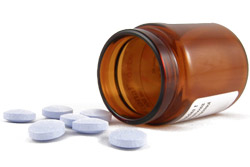Introduction

Antiretroviral (ARV) medications are the best available treatment for HIV. Antiretroviral therapy (ART) uses a combination of ARV medications to limit and control the HIV replication cycle by inhibiting key viral enzymes. The proper use of ARTs has been consistently proven to reduce deaths and illnesses due to HIV. However, if ART is not used properly, such as only being taken intermittently or occasionally, treatment-resistant HIV strains can emerge. ART regimens should to be individualised depending on the strain of HIV, effectiveness of treatments, drug toxicity, how well tolerated the medications are, how frequently they need to be taken, interactions with other drugs or illnesses, financial costs and individual preferences. If a strain of HIV is susceptible to ART and individuals take the medications as directed, HIV replication is reliably suppressed in 80% of cases.
The World Health Organization (WHO) recommends certain combinations of ARV drugs to achieve the best effectiveness. The first choices for ART should be two nucleoside/nucleotide reverse transcriptase inhibitors (NRTIs), one of which should be zidovudine or tenofovir, and a non-nucleoside reverse transcriptase inhibitor (NNRTI). A second-line ART regimen should consist of a ritonavir-boosted protease inhibitor (PI) plus two NRTIs, one of which should be zidovudine or tenofovir.
Book your health appointments online
Find and instantly book your next health appointment with Healthengine
How do they work?
HIV spreads around the body through a complex interaction with CD4+ immune cells. It initially binds to CD4+ T cells via cell receptors on their surface. HIV can then enter the cytoplasm, where the viral enzyme reverse transcriptase creates HIV DNA. This DNA then enters the human immune cell nucleus, where it is incorporated into the human DNA strand by the activity of another viral enzyme called viral integrase. As the human cell machinery creates proteins from the DNA template, HIV exploits this system to create more viral particles and enzymes. These viral particles are then released into the bloodstream to infect further CD4+ immune cells. If the HIV viral replication cycle continues unrestricted, it will eventually result in a total depletion of CD4+ immune cells.
NRTIs were the first drug classes licensed for treating HIV. NRTIs and NNRTIs act on the viral enzyme reverse transcriptase and inhibit its activity. Protease inhibitors (PIs) act on the viral enzyme protease, which is responsible for assembling new virus particles. Blocking viral protease slows the production and release of these new virus particles that infect other immune cells.
Examples of protease inhibitors include:
- Saquinavir (e.g. Invirase);
- Indinavir (e.g. Crixivan);
- Ritonavir (e.g. Norvir);
- Amprenavir (e.g. Agenerase);
- Fosamprenavir (e.g. Telzir);
- Lopinavir (e.g. Kaletra);
- Ritonavir (e.g. Norvir);
- Atazanavir (e.g. Reyataz);
- Tipranavir (e.g. Aptivus);
- Darunavir (e.g. Prezista).
PIs have been demonstrated to suppress HIV replication in the majority of patients when combined with reverse transcriptase inhibitors. Additionally, the PI ritonavir also slows the breakdown of other PI drugs, hence PI drugs are often combined with a low dose of ritonavir to boost their activity (e.g. ritonavir-boosted lopinavir). If PIs are used as a single drug rather than in a combination ART regimen, HIV resistance will emerge relatively quickly.
 |
For more information on the other classes of anti-retroviral therapies, see Antiretroviral Therapy (Anti-HIV Drugs). |
How well do they work?
The main PIs used in the treatment of HIV are darunavir, lopinavir and atazanavir. The WHO recommends that PIs be used only in second-line regimens for treating HIV. This means they are used when first-line regimens have failed, or if individuals with HIV are not able to tolerate a first-line therapy. WHO recommends using a ritonavir-boosted protease inhibitor plus two NRTIs for second-line antiretroviral therapy. They also recommend ritonavir-boosted atazanavir or lopinavir as the preferred PIs.
Darunavir
A randomised controlled trial of darunavir established that ritonavir-boosted darunavir was not inferior to ritonavir-boosted lopinavir to suppress HIV replication after 96 weeks of HIV treatment. By 96 weeks, a significantly greater proportion of darunavir-treated patients had achieved a viral load of < 50 copies per ml. There was no difference between the two drugs in terms of rates of side effects.
Lopinavir
Lopinavir has been tested extensively in clinical trials. One randomised trial compared lopinavir, stavudine and lamivudine combination therapy against nelfinavir, stavudine and lamivudine in 653 individuals with HIV. By 48 weeks, a significantly higher percentage of patients treated with lopinavir had HIV RNA copies less than 50 copies/mL than in the individuals treated with nelfinavir (67% vs. 52%).
A separate trial evaluated the use of lopinavir in 100 children with HIV. Patients received one of two different doses of ritonavir-boosted lopinavir, plus lamivudine and stavudine. By 48 weeks, 80% of patients achieved sustained HIV suppression, and CD4 cell counts increased by an average of 404 cells/mm3.
Atazanavir
The use of atazanavir was examined in a randomised trial of 883 individuals with HIV. Patients received either ritonavir-boosted atazanavir or ritonavir-boosted lopinavir, both in combination with tenofovir and emtricitabine. Patients receiving atazanavir had a median increase in CD4+ cell count of 261 cells/mm3 by 96 weeks, while the lopinavir group had an increase of 273 cells/mm3 at 96 weeks.
Side effects

Darunavir
Side effects are very similar for darunavir and ritonavir-boosted darunavir. The majority of side effects are mild and the most frequent (≥ 5% of patients) are diarrhoea, headache and abdominal pain. Rates of side effects for children are similar to those for adults.
Lopinavir
The most common side effect associated with lopinavir is diarrhoea, generally of mild or moderate severity. Other common side effects (≥ 5% of patients) are predominantly gastrointestinal symptoms, such as abdominal pain, abnormal faeces, diarrhoea, indigestion, nausea, vomiting, weakness, headache, and lipodystrophy. In children, the most commonly reported side effects were altered taste sensations, vomiting, diarrhoea and rash.
Atazanavir
Rates of side effects are similar for atazanavir compared to ritonavir-boosted atazanavir, except that jaundice and elevated bilirubin can be more frequent in ritonavir-boosted atazanavir. The common (1–9%) side effects associated with atazanavir use are scleral icterus (the white of the eye appears yellow), abdominal pain, diarrhoea, indigestion, nausea, vomiting, jaundice, rash, weakness, lipodystrophy and fatigue.
Conclusion
There are more trials on the use of PIs for treating HIV/AIDS ongoing, particularly on new combinations of ARV drugs and their relative risks and benefits. It is important that doctors and individuals with HIV consult closely to select the most appropriate treatment, which depends on medical history, other illnesses, prior ARV treatments, stage of the HIV infection and individual preferences. It is highly recommended that individuals living with HIV are managed by a specialist HIV service, if one is available.
References
- Centers for Disease Control and Prevention (CDC). The Global HIV/AIDS pandemic, 2006. MMWR Morb Mortal Wkly Rep. 2006;55(31):841-4. [Abstract | Full text]
- Lane HC. Pathogenesis of HIV infection: total CD4+ T-cell pool, immune activation, and inflammation. Top HIV Med. 2010; 18(1): 2-6. [Abstract]
- Schneider E, Whitmore S, Glynn MK, et al. Revised surveillance case definitions for HIV infection among adults, adolescents, and children aged < 18 months and for HIV infection and AIDS among children aged 18 months to < 13 Years. MMWR Recomm Rep. 2008;57(RR-10):1-12. [Abstract | Full text]
- Thompson MA, Aberg JA, Cahn P, et al. Antiretroviral treatment of adult HIV infection: 2010 recommendations of the International AIDS Society-USA panel. JAMA. 2010;304(3):321-33. [Abstract | Full text]
- Antiretroviral therapy for HIV infection in adults and adolescents [online]. Geneva: World Health Organization; 2010 [cited 12 August 2012]. Available from: [URL link]
- Antiretroviral drugs [online]. Melbourne, VIC: Therapeutic Guidelines; 2012 [cited 15 August 2012]. Available from: [URL link]
- Braunwald E, Fauci AS, Kasper DL, et al. Harrison’s Principles of Internal Medicine (15th edition). New York: McGraw-Hill Publishing; 2001. [Book]
- Darunavir [online]. St Leonards, NSW: MIMS Online; 20 April 2012 [cited 9 October 2012]. Available from: [URL link]
- Lopinavir [online]. St Leonards, NSW: MIMS Online; 16 April 2012 [cited 11 October 2012]. Available from: [URL link]
- Atazanavir [online]. St Leonards, NSW: MIMS Online; 14 February 2012 [cited 9 October 2012]. Available from: [URL link]
- Ortiz R, Dejesus E, Khanlou H, et al. Efficacy and safety of once-daily darunavir/ritonavir versus lopinavir/ritonavir in treatment-naive HIV-1-infected patients at week 48. AIDS. 2008; 22(12): 1389-97. [Abstract | Full text]
- Product Information: Prezista (Darunavir). North Ryde, NSW: Janssen-Cilag Pty Ltd (Australia); July 2010. Available from: [URL link]
- Product Information: Kaletra (Lopinavir/Ritonavir). Botany, NSW: AbbieVie Pty Ltd (Australia); 21 Aug 2012. Available from: [URL link]
- Product Information: Reyataz (Atazanavir). Botany, NSW: AbbieVie Pty Ltd (Australia); 16 May 2012. Available from: [URL link]
All content and media on the HealthEngine Blog is created and published online for informational purposes only. It is not intended to be a substitute for professional medical advice and should not be relied on as health or personal advice. Always seek the guidance of your doctor or other qualified health professional with any questions you may have regarding your health or a medical condition. Never disregard the advice of a medical professional, or delay in seeking it because of something you have read on this Website. If you think you may have a medical emergency, call your doctor, go to the nearest hospital emergency department, or call the emergency services immediately.







